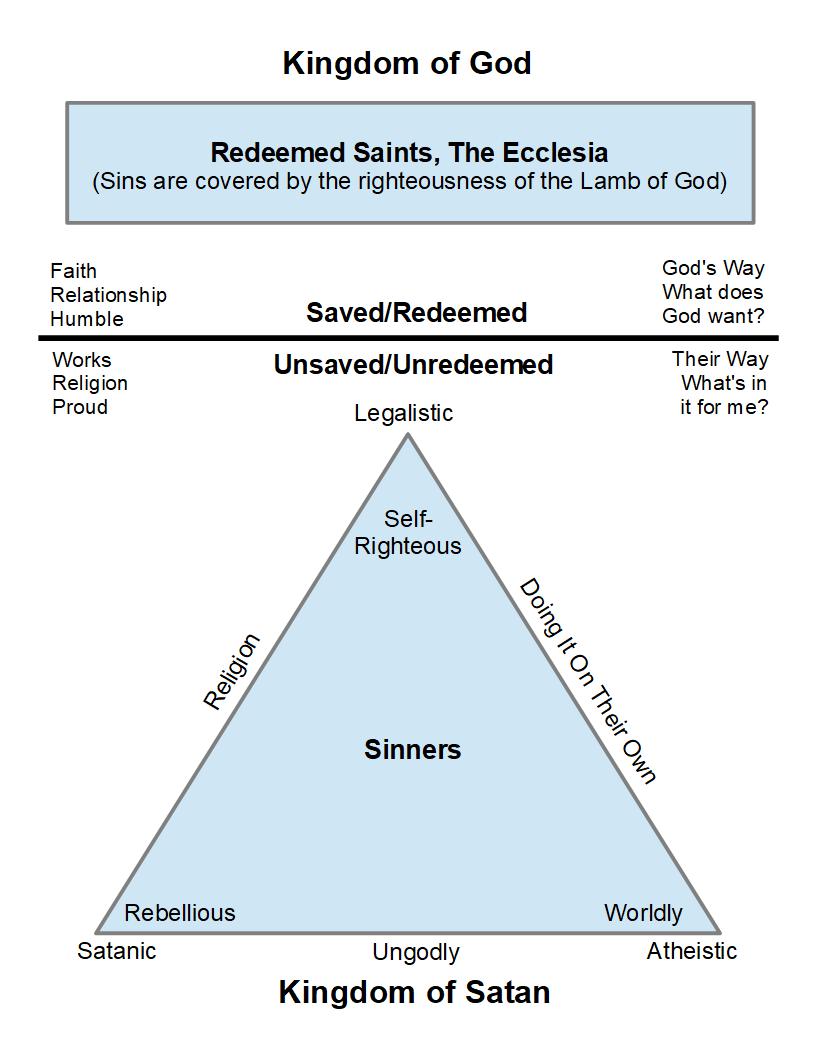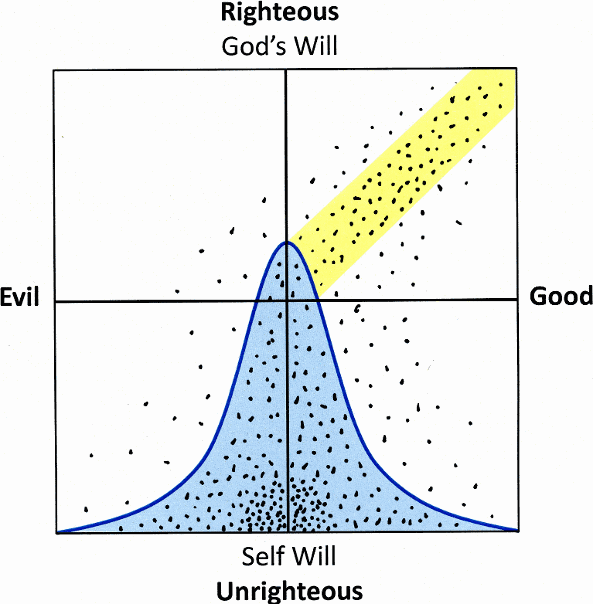Thoughts About
Fundamental Things
Saints and Sinners
Rockey Jackson, April 22, 2018
"For the Lord loves justice, and does not forsake His saints; they are preserved forever, but the descendants of the wicked shall be cut off." (Psalms 37:28)
The human race may be divided into two groups: saints and sinners. The following illustration and explanation provides definitions and distinctions between these two groups. The purpose is to affirm, liberate and empower the redeemed saints of God.

Saints are in the Kingdom of God while sinners are in the Kingdom of Satan. Sinners may be one of three extremes, but are often a less extreme combination of the three. There are the self-righteous who are trusting in their own good works to be acceptable to God. Then there are the rebellious who openly resist God's authority. Finally there are the worldly who do their best to ignore God even proclaiming that he doesn't exist. Now there is considerable confusion because the two kingdoms use different definitions for sinners, saints and many other terms used in connection with this subject.
In the New Testament, the word saint comes from the Greek word hagios. One lexicon gives four definitions for hagios:
-
properly reverend, worthy of veneration
-
set apart for God, to be, as it were, exclusively His
-
of sacrifices and offerings; prepared for God with solemn rite, pure, clean
-
in a moral sense, pure, sinless, upright, holy.
Definition two is the way saint is to be understood in this article. A saint is a person who is set apart for God to be exclusively His. Redeemed is added as a reminder that saints are not sinless. They have been redeemed by Jesus Christ as their Lord and Savior and their sins are covered by the righteousness of the perfect Lamb of God. Ecclesia comes from the Greek word ekklesia. In general it means a gathering of citizens called out from their homes into some public place; an assembly. For both Jews and Christians it came to mean the totality of the faithful, especially when gathered for worship. Here it is used to refer to all redeemed saints who have been called out of the Kingdom of Satan and gathered into the Kingdom of God. A computer search for the world's definition of a saint returned:
-
a person acknowledged as holy or virtuous and typically regarded as being in heaven after death
-
used in titles of those formally recognized as religious saints; canonized.
The first definition is the way those outside the Kingdom of God generally see self righteous sinners and they don't really understand redeemed saints at all.
Sinner comes from the Greek word hamartolos, which means; devoted to sin, a sinner. The lexicon goes on to note that the New Testament makes a distinction between not being free from sin, as all men are sinners, and those who are preeminently sinful, especially wicked, devoted to sinning. As stated above, sinners may be one of three extremes and are usually some combination of the three: self-righteous, rebellious, or worldly. The self-righteous tend to be legalistic, the rebellious tend to be satanic and the worldly tend to be atheistic. The self-righteous and the rebellious often have religion in common. The self-righteous and the worldly share the trait of doing it their own way. The rebellious and the worldly are both ungodly.
The rebellious and worldly with their satanic and atheistic ways are pretty easy to distinguish from redeemed saints. The self-righteous, however, can be very difficult to distinguish because they share many commonalities with redeemed saints. Both want to please God and be acceptable to him. The redeemed saints came to God in humility with nothing but their faith, trusting that God would save and redeem them. The self-righteous come to God in pride, believing that their good works will make them acceptable in His sight. Both want to be obedient to God. The redeemed saints have developed a relationship with God, they are obedient to the spirit of the law that God has written on their hearts. The self-righteous are religious and legalistically follow the letter of the law of their religion. Saints and sinners are separated by the redeemed saints doing it God's way while the self-righteous say in their hearts: “I'll do it my way.” In the end the spiritually minded redeemed saints are asking the question: “What does God want?' The carnally minded self-righteous in contrast ask the question: “What's in it for me?”
This gets even more confusing because the self-righteous want to appear righteous before God and man. They expend great effort to look good. They talk about how faithful they are to their religion, how many meetings they attend and how many religious programs they watch. Often they are much better at performing good works in the world that the redeemed saints should also do. They have an objective written set of rules and they can point to them, boasting about how well they obey the rules. The redeemed saints, on the other hand, can be a rather motley group. To begin with they were all sinners who were saved by the grace of God. They have no pretense of perfection. Their spirits were reborn at conversion, but their souls are in the process of being sanctified throughout their lifetime and their flesh will not be redeemed until they receive heavenly bodies at the resurrection of life. They talk about their relationship with God who to them is a loving father, brother and friend. How can they explain the subjective nature of God's law written on their heart and their obedience to God's individual will just for them?
In heaven there will be God, redeemed saints, and angels. Sinners will be excluded. Here in the world, however, saints and sinners rub shoulders, living side by side with each other. Any member of either group my be good or evil according to the world's judgment. They may be nice or mean. They may be great to hang out with or someone to avoid at all cost. None of that has anything to do with being redeemed. The world believes that good and evil are the same as righteousness (God's will) and unrighteousness (self will). They are not the same thing at all. Ever since Adam and Eve ate the forbidden fruit in the Garden of Eden people have been able to judge good and evil, but God's ways are higher than our ways and His thoughts are higher than our thoughts (Isaiah 55:8-9). If righteousness and goodness were plotted on a Cartesian coordinate scale with each dot representing a person it might look like the illustration below (but with a lot more dots). The illustration is not based on any factual data, but is only to help visualize the concept.

It could be expected that most of the dots would be congregated in a normal bell curve pattern in the bottom half of the illustration. Perhaps the largest grouping would be near the bottom and close to the righteous/unrighteous axis. That's because most people are not all that good or bad, they are just doing their own thing. Another pattern would be a broad line of dots ascending from the top of the bell curve toward the upper right corner, because righteous people also tend to be seen as good. There won't be many dots in the upper left quadrant because it is unusual for something to be both righteous and evil, but the world does judge some of God's deeds to be evil. This will only increase in the last days as the unredeemed call evil good and good evil.
Saints and sinners have existed together since the fall from grace and will continue to the end of this age. Speaking of the first two brothers the Bible tells us that Cain brought God a sacrifice of his works while Able brought a sacrifice of faith. Cain's sacrifice was rejected and Abel's sacrifice was accepted. In his self-righteous wrath, Cain killed his brother Abel. When Saul was rejected by God because of his fear of man and pride, he persecuted and tried to kill David who, because of his faith, God called a man after my own heart. When Jesus ministered on the earth he was opposed by the Pharisees (self-righteous), the Sadducees (holding the form of religion while denying its power), the Herodians (worldly) and all the rebellious who followed Beelzebub in his many forms. In Matthew 23 Jesus pronounced seven woes on self righteous hypocrites. In verses 29-35 he details how they persecute the saints throughout history. In the end the self-righteous, religious, worldly and rebellious all conspired together to kill the perfect Lamb of God who was their only salvation.
In the world, saints still exist with sinners in all their various forms and sinners are in all religious organizations, even those with a Christian label. For the self-righteous, it is their natural habitat. Most sincerely want to please God and be obedient to his law. In their pride they believe their own efforts will be enough to earn their redemption. There are some worldly sinners in religious organizations for many reasons: it may be the culture they grew up with, it may have to do with relationships or it could be just for the social benefits of belonging. If the rebellious sinners belong to a religious organization it is usually one that worships Satan in one form or another. However a few of them also attend Christian churches to see if there is anything godly or righteous going on so they can curse it. If they have enough influence they may even throw a monkey wrench into the machinery and stop it all together.
Saints certainly want to accept into their fellowship all who truly want to come to God, but the sinners described above are hypocrites, actors who can put on a very good show of godliness. A person's faith, humility, desire to please God and be in relationship with Him is easy for God to Judge because He judges the heart of a person. For the saints it is very difficult to judge because they only see the external actions and fruit may take a lifetime to mature. In Matthew 13:24-30 Jesus gave the parable of the wheat and the tares. In it He explained how God has sown good seed into the earth, but His enemy has come and sown bad seed in the same field causing tares to grow up along with the wheat. Both the wheat and the tares continue to grow together until the harvest when the wheat is gathered unto God and the tares are burned with fire. As we noted above, saints were sinners who were saved by the grace of God. In the next article in this series we'll see how the tares (sinners) can escape the fire. It is entitled: “How Sinners Become Saints.”
(If you'd like a fuller discussion of the parable of the wheat and the tares, the author wrote about it as part of a larger article some years ago. Here is the link to the question: “Do We Have Tares in Our Wheat?”)
The Radiant Cross
This radiant cross was captured at driftwood beach on Jekyll Island, Georgia, U.S.A. There is nothing more fundamental to the Christian faith than the cross of Calvary.
The Foundation Series
